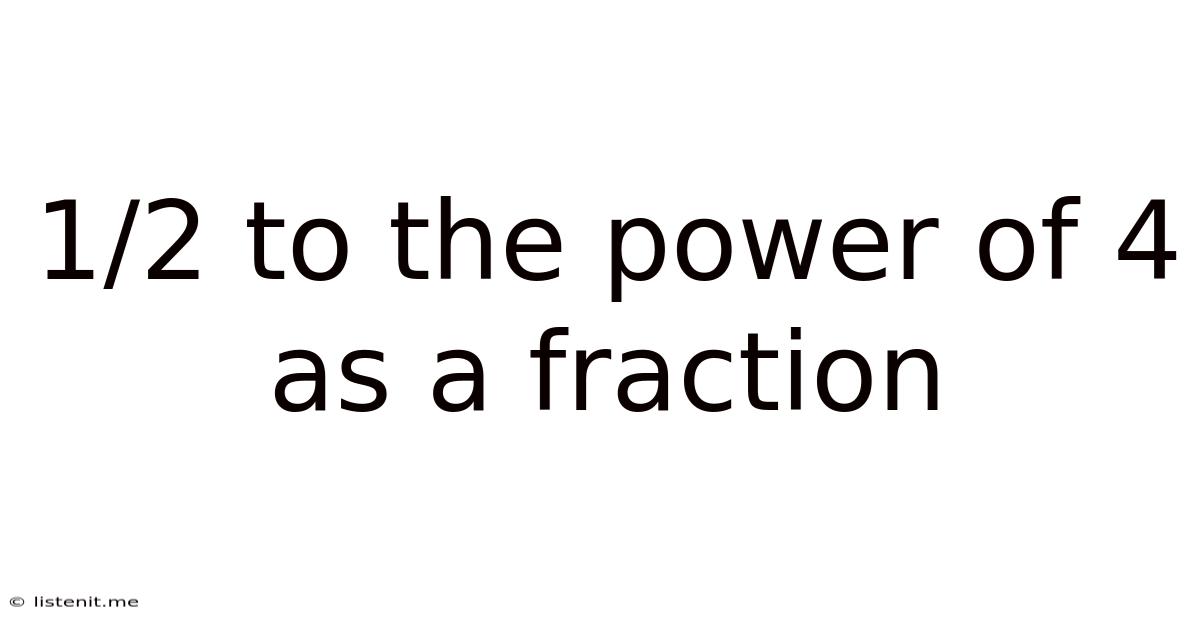1/2 To The Power Of 4 As A Fraction
listenit
May 25, 2025 · 4 min read

Table of Contents
1/2 to the Power of 4 as a Fraction: A Comprehensive Guide
Understanding exponents, particularly when dealing with fractions, can sometimes feel daunting. This comprehensive guide will demystify the concept of raising a fraction to a power, focusing specifically on (1/2)⁴. We'll explore the process step-by-step, delve into the underlying mathematical principles, and examine related concepts to solidify your understanding. This guide aims to provide not only the answer but also the conceptual framework for solving similar problems.
Understanding Exponents
Before we tackle (1/2)⁴, let's review the fundamental concept of exponents. An exponent, also known as a power or index, indicates how many times a base number is multiplied by itself. For instance, in the expression 2³, the base is 2, and the exponent is 3. This means 2 multiplied by itself three times: 2 x 2 x 2 = 8.
Key Terminology:
- Base: The number being raised to a power. In our case, the base is 1/2.
- Exponent: The number indicating the number of times the base is multiplied by itself. Here, the exponent is 4.
- Power: The entire expression, including the base and exponent. (1/2)⁴ is a power.
Calculating (1/2)⁴
Now, let's calculate (1/2)⁴. This means we multiply 1/2 by itself four times:
(1/2)⁴ = (1/2) x (1/2) x (1/2) x (1/2)
To multiply fractions, we multiply the numerators (top numbers) together and the denominators (bottom numbers) together:
(1 x 1 x 1 x 1) / (2 x 2 x 2 x 2) = 1/16
Therefore, (1/2)⁴ = 1/16
Applying the Power Rule for Fractions
There's a more efficient way to solve this type of problem using the power rule for fractions. This rule states that when raising a fraction to a power, you raise both the numerator and the denominator to that power individually. Mathematically:
(a/b)ⁿ = aⁿ/bⁿ
Applying this rule to (1/2)⁴:
(1/2)⁴ = 1⁴/2⁴ = 1/16
This method simplifies the calculation, especially when dealing with larger exponents.
Understanding the Result: 1/16
The result, 1/16, represents a fraction less than one. This is expected because we are repeatedly multiplying a fraction (1/2) which is less than one. Each multiplication results in a smaller and smaller fraction. Visualizing this can be helpful: imagine repeatedly halving a whole. First, you have 1/2. Then, halving that gives 1/4. Halving again gives 1/8, and finally, 1/16.
Extending the Concept: Negative Exponents
What happens if the exponent is negative? For example, let's consider (1/2)⁻⁴. A negative exponent indicates the reciprocal of the base raised to the positive exponent. In other words:
a⁻ⁿ = 1/aⁿ
Applying this to (1/2)⁻⁴:
(1/2)⁻⁴ = 1/(1/2)⁴ = 1/(1/16) = 16
Therefore, (1/2)⁻⁴ = 16
This demonstrates that raising a fraction to a negative exponent results in a value greater than one.
Real-World Applications
While this may seem like a purely mathematical exercise, understanding fractional exponents has numerous real-world applications:
- Compound Interest: Calculating compound interest involves repeated multiplication, often involving fractions representing interest rates.
- Decay Rates: Exponential decay, such as radioactive decay or the depreciation of an asset, can be modeled using fractional exponents.
- Probability: Calculating probabilities of events occurring repeatedly often involves raising fractions to powers.
- Computer Science: Binary numbers (base-2) and data compression frequently use powers of fractions.
- Physics: Many physical phenomena, like the intensity of light or sound, are described using exponential functions involving fractions.
Further Exploration: Decimal Representation
While the fractional representation (1/16) is precise, it's sometimes useful to express the result as a decimal. To convert 1/16 to a decimal, simply perform the division:
1 ÷ 16 = 0.0625
Therefore, (1/2)⁴ = 0.0625
Practice Problems
To further solidify your understanding, try solving these practice problems:
- (1/3)³
- (2/5)²
- (3/4)⁻²
- (1/10)⁵
- (5/2)³
Conclusion: Mastering Fractional Exponents
Mastering the concept of raising fractions to powers is crucial for success in various fields. By understanding the fundamental principles of exponents, the power rule for fractions, and the implications of negative exponents, you can confidently tackle a wide range of mathematical problems. Remember, consistent practice is key to developing a deep understanding and building your problem-solving skills. This comprehensive guide has provided you with the necessary tools and knowledge to approach similar calculations with ease and accuracy. Continue to explore these concepts, and you'll find that the initially complex world of fractional exponents becomes increasingly accessible and even enjoyable.
Latest Posts
Latest Posts
-
Write 61 80 As A Decimal Number
May 26, 2025
-
3 2 To The Power Of
May 26, 2025
-
What Is The Greatest Common Factor Of 5
May 26, 2025
-
What Is The Greatest Common Factor Of 2 And 4
May 26, 2025
-
Greatest Common Factor Of 21 And 49
May 26, 2025
Related Post
Thank you for visiting our website which covers about 1/2 To The Power Of 4 As A Fraction . We hope the information provided has been useful to you. Feel free to contact us if you have any questions or need further assistance. See you next time and don't miss to bookmark.